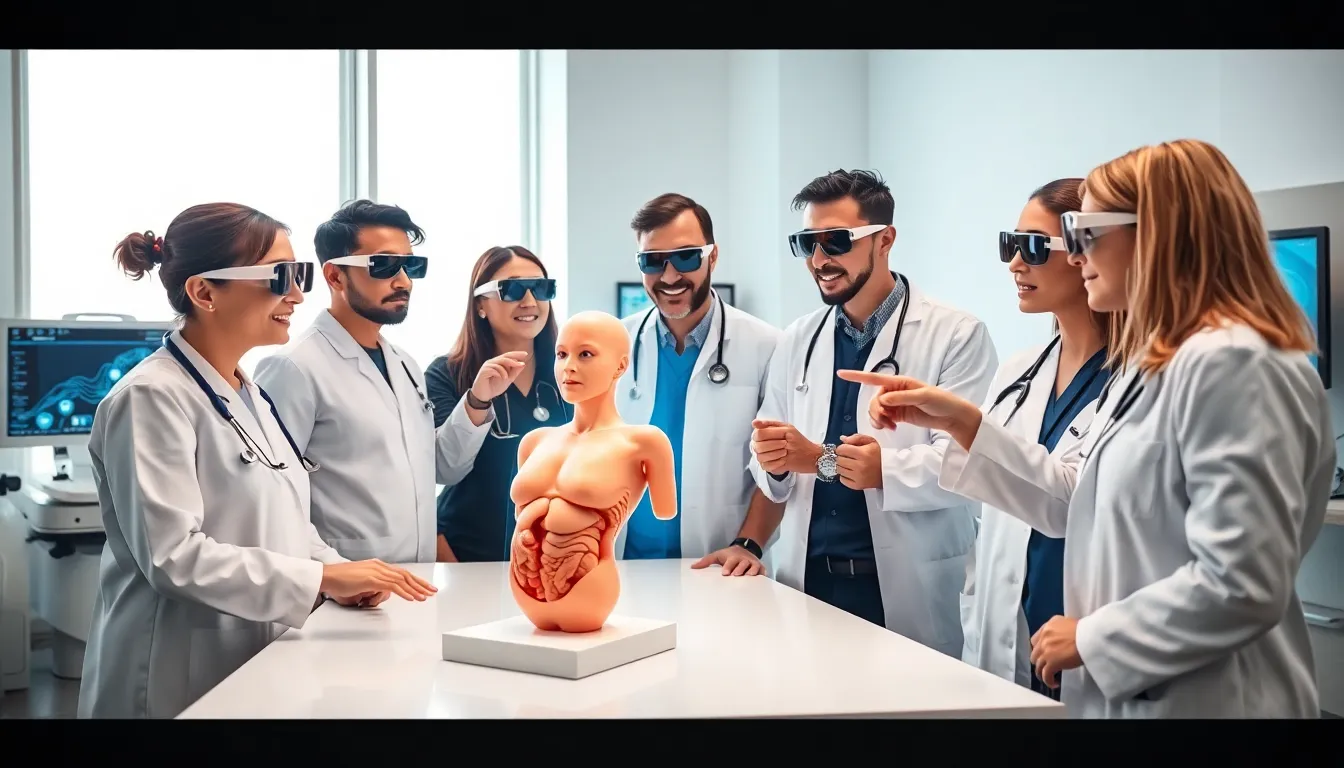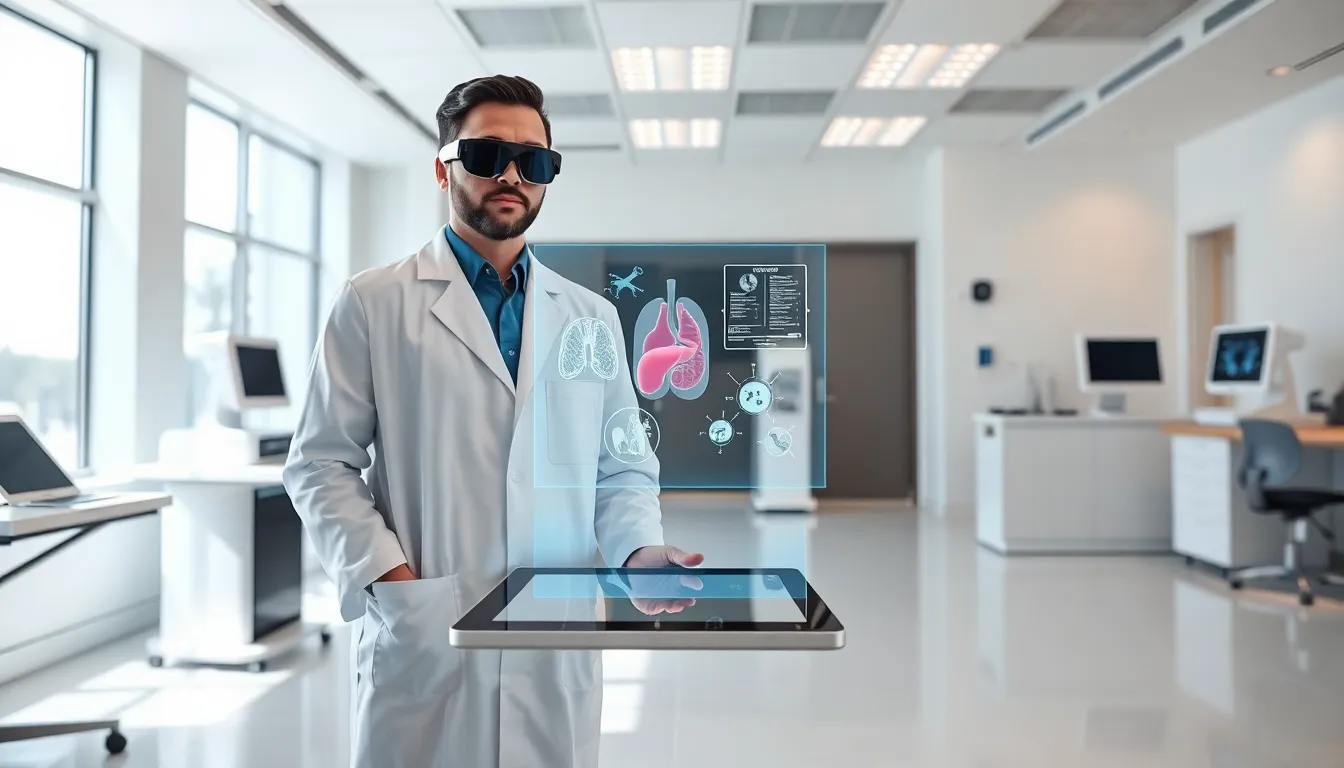Imagine walking into a doctor’s office, and instead of staring at those outdated medical charts, you get to play with holograms of your organs. Sounds like a scene straight out of a sci-fi movie, right? Well, welcome to the world of Augmented Reality (AR) in healthcare. This cutting-edge technology isn’t just cool: it’s transforming patient care, medical training, and the overall healthcare landscape. If you think the future is all about robots and flying cars, just wait until you see what AR can do for doctors, nurses, and patients alike. Get ready to explore how AR is changing the game in the medical field.
Table of Contents
ToggleUnderstanding Augmented Reality

Augmented Reality, often abbreviated as AR, is a technology that overlays digital information, such as images and sound, onto the real world. Think of it as putting on a pair of smart glasses that make your everyday environment look like a high-tech display. This tech combines a user’s physical surroundings with virtual elements, creating a mixed reality experience. For instance, while a person looks at their living room through their AR glasses, they might also see virtual furniture options layered over the existing space. In the healthcare context, AR provides medical professionals with supercharged tools to visualize anatomy and procedures without having to rely solely on traditional imaging techniques.
Among the most popular AR tools is Microsoft’s HoloLens, which has found a place in various medical applications, empowering practitioners with detailed visualizations that enhance their decision-making process. As AR technology continues to evolve, understanding its potential in hospitals, clinics, and even at home becomes increasingly important.
Applications of Augmented Reality in Healthcare
Augmented Reality is making significant inroads in various aspects of healthcare. One striking application is in surgical settings where AR can project vital information directly onto the surgeon’s field of view. For example, during a complex operation, a surgeon can see a 3D representation of a patient’s internal organs, thanks to real-time imaging data overlaid on their visual field. This leads to enhanced precision and minimizes the risk of errors.
Also, medical training has benefited immensely from AR technologies. Simulators that use AR help medical students practice procedures before they ever step foot in an operating theater. By simulating real-life scenarios, students can develop their skills and confidence in a low-risk environment. Companies like Osso VR provide immersive platforms that allow trainees to experience surgeries in an interactive manner.
Patient education is another crucial area where AR shines. Through AR applications, patients can visualize their medical issues and treatment options. Imagine a patient seeing a 3D model of their tumor and watching how a specific treatment plan targets it, all while discussing it with their doctor. This not only enhances understanding but also empowers patients in their healthcare decisions.
Benefits of Augmented Reality in Medical Training
The integration of Augmented Reality in medical training opens doors to numerous advantages. First and foremost, AR provides an immersive learning experience that textbooks simply can’t replicate. By allowing students to interact with 3D anatomical models, AR makes learning more engaging. The technology sparks curiosity and encourages active participation, aspects crucial to retaining complex information.
Also, AR training modules allow for repetitive practice without the high stakes involved with real patients. Errors made in the training phase do not translate into real-life consequences. This iterative learning style significantly boosts confidence among medical trainees. Also, with AR, instructors can tailor courses to meet individual learning paces, allowing each student to develop a personalized learning experience.
Finally, the collective data generated from AR training can lead to continuous improvements in educational techniques, ensuring that future doctors are equipped with the best information available. This adaptive learning model fosters a new breed of well-prepared medical professionals.
Enhancing Patient Care with Augmented Reality
Augmented Reality is not just a tool for healthcare professionals but is directly enhancing patient care. For instance, certain AR applications can help in pain management. Imagine a patient lying in a hospital bed who can use AR to create a calming environment with visuals of serene landscapes. This distraction technique can significantly reduce anxiety and discomfort, making the recovery experience more pleasant.
Besides, AR can serve as a bridge for better patient-clinician communication. When a doctor and a patient use AR to visualize medical procedures together, it fosters a collaborative environment. Patients are more likely to feel involved and informed about their treatments, which can lead to better adherence to medical advice and treatment plans.
In pediatric care, AR applications designed to entertain children during medical procedures can alleviate fear and stress. By turning a potentially frightening experience into a playful one, children are less anxious, and healthcare providers can perform their tasks more smoothly.
Challenges and Limitations of Augmented Reality in Healthcare
Even though the transformative potential of Augmented Reality in healthcare, challenges remain. A principal issue is the cost associated with AR technology and its implementation in healthcare facilities. Not all providers can afford high-end AR systems, which can create discrepancies in the availability of advanced care.
Also, there is the challenge of training staff to use AR effectively. Without proper training, even the most sophisticated technology can fall short of its potential. Besides, privacy concerns are prevalent, particularly when dealing with patient data. The integration of AR necessitates stringent data protection measures to ensure compliance with regulations like HIPAA.
Finally, while AR can enhance real-world perceptions, it cannot replace the human touch in medicine. Empathy, understanding, and communication are irreplaceable components of effective healthcare that AR cannot mimic.
Future Trends in Augmented Reality for Healthcare
Looking ahead, the future of Augmented Reality in healthcare is packed with exciting possibilities. One trend is the advancement of AR devices, becoming more affordable and accessible. This democratization of technology could lead to broader adoption across general practices, not just specialized facilities.
Another trend is the development of wearable AR headsets that will allow healthcare providers to access information hands-free during procedures. Physicians could navigate their digital resources seamlessly while concentrating on the patient, which improves efficiency and effectiveness.
Also, as AR integrates with artificial intelligence, the personalization of care will take a major leap forward. Imagine algorithms analyzing a patient’s history, enabling AR to provide tailored visualizations relevant to their specific health condition. This combination could usher in an era where healthcare is not only reactive but also proactive, anticipating medical issues before they escalate.





